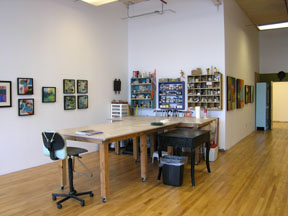

Her second husband, whom she married in 1944, was Saul Steinberg, artist and illustrator, made famous by his New Yorker magazine covers.

Iconic New Yorker cover from March 1976 by Saul Steinberg, "View of the World from 9th Avenue"
Hedda's appearance in the Irascibles photo had nothing to do with Saul Steinberg or anyone else but herself. She was an artist who had shown with the Abstract Expressionists and signed the letter of protest, but she refused to categorize her work as Abstract Expressionism. She "grew up with Surrealism" thanks to an artist friend and studied art in Vienna, Bucharest and Paris. She exhibited collages in the "Surindependents" exhibition of 1938 in Paris, where Jean Arp saw her work and arranged to have one of her collages sent to the Guggenheim Jeune gallery in London.
Throughout her life she experimented with various subjects, mediums and techniques, sometimes prompted by observation and other times by ideas, but "at all times I have been moved...by the music of the way things are...And through all this pervades my feeling that I am only one small speck (hardly an atom) in the uninterrupted flux of the world around me." (This quote is from a wonderful article and interview by Joan Simon in Art in America from February 2007 when Sterne was age 96 .) "Uninterrupted Flux" provided the title of a traveling show and catalogue that organized her varied career and work into thematic and chronological groupings.

"Further I", 1984, acrylic and crayon on canvas, 72" x 52." (This image is from a 2007 article in The Brooklyn Rail.)
Sterne said that she had originally been interested in architecture but that she was bad at math so she studied art instead.

"Machine 5" from 1950. "I had a feeling that machines are unconscious self-portraits of people's psyches: the grasping, the wanting, the aggression that's in a machine. That's why I was interested to paint them. And I called them "anthropographs"--maybe it was pretentious thinking [laughs]." (from the Joan Simon interview in Art in America)
Sterne went her own way throughout her career: "I took it for granted that art is essentially an act of freedom. You react to the world totally freely. I met many artists in New York who believed progress is linear, from figure to abstract. In my work I never followed that idea." (from the Joan Simon interview)

Photos of work by Sterne are difficult to find on the internet. Although she drew and painted portraits throughout her life, I could not find any to show here, but just from these three images, you can see how varied her work is. And yet, she is known not for her work but for her appearance in that Irascibles photo, which must have been very annoying.
From everything that I could find, Hedda Sterne is still alive. She would now be aged 99. During the interview that Joan Simon did with her in 2006 when Sterne was 96, she referred to her macular degeneration that began in 1997 causing her to stop painting and the stroke she suffered in 2004 that ended her drawing. She was then mostly blind and able to read for only 15 or 20 minutes at a time with a machine.
Joan Simon asked Sterne how she spent her days, and her reply was so evocative and especially meaningful to me because of my mother's age and infirmity. It gave me greater insight into the feelings of someone who is so old but still has her mental capacity and ability to express herself:
"Now that I am so old and incapacitated, I don't do anything with great enthusiasm. You know, thinking, dreaming, musing become essential occupations. I am watching my life. As if I'm not quite in it, I watch it from the outside. Because after so many years of working unceasingly, and enthusiastically, being idle is a tremendous effort of concentration and adjustment.
The luck is that there is less energy. That's a compensation. It makes it easier. Just sitting. I saw peasants in Romania, you know, on Sunday, when they get up all summer at 4 and work incessantly until noon, let's say. And Sunday they just sit, and their resting is so active - like an activity, resting. It's a beauty to behold, you know. It's not just doing nothing. It's being and existing in a certain way. In a way old age is a little bit like that. It has its beauties."






